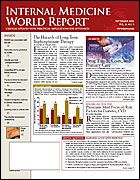Publication
Article
Internal Medicine World Report
Colesevelam Offers Add-on Benefits in Type 2 Diabetes
Author(s):
WASHINGTON, DC—Early research on the bile-acid sequestrant colesevelam (Welchol) raised eyebrows with its unanticipated glucose-reducing effects in patients with type 2 diabetes. With growing awareness that some patients cannot use metformin (Glucophage) or thiazolidinediones because of potential complications, a preliminary trial was conducted to quantify colesevelam’s potential for use as a glycemic control aid.
Results of the 3 separate analyses were presented at the 66th Scientific Sessions of the American Diabetes Association.
The Glucose Lowering Effect Of WelChol Study (GLOWS) included 65 patients (mean age, 56 years) who were already taking either a sulfonylurea, metformin, or a combination of these agents. Patients were included if their hemoglobin (Hb) A1c levels were from 7% to 10%; they were randomized to colesevelam (3.75 g/d) or matching placebo and were instructed to continue their anti-diabetic regimens.
P
Analysis showed a significantly greater reduction in HbA1c from baseline to 12 weeks, the primary end point, in the colesevelam group compared with the placebo group ( = .007). The difference was more pronounced in patients with an HbA1c ≥8% at baseline. Overall, treatment reduced HbA1c by 0.5% compared with placebo.
P
The secondary end point, changes in postprandial glucose, was evaluated with measurements of plasma glucose in the fasting state and 1 hour after consuming a test meal. Patients took 3 active tablets 5 minutes before the test meal. At 12 weeks, changes in postprandial glucose were significantly greater in the colesevelam group than in the placebo group ( = .026).
Colesevelam was well tolerated. Minor gastrointestinal effects were most commonly reported. Treatment-emergent side effects during the study were similar in both groups.
IMWR
Lead investigator Sherwyn L. Schwartz, MD, of the University of Texas, San Antonio, noted that about 10% to 15% of patients cannot take statins because of muscle aches. “There is a group of patients with glucose out of control and elevated lipids who are candidates for these benefits,” he told .
Coinvestigator Franklin Zieve, MD, of Hunter Holmes McGuire Veterans Affairs Medical Center, Richmond, Va, noted that the 0.5% reduction in HbA1c with colesevelam meets the usual FDA standard for glycemic control agents. He added that colesevelam would most likely be used as add-on therapy, not monotherapy. “It has the side benefit of lowering low-density lipoprotein, which you want to do in diabetics anyway.” A phase 3 study involving several hundred patients is under way.





